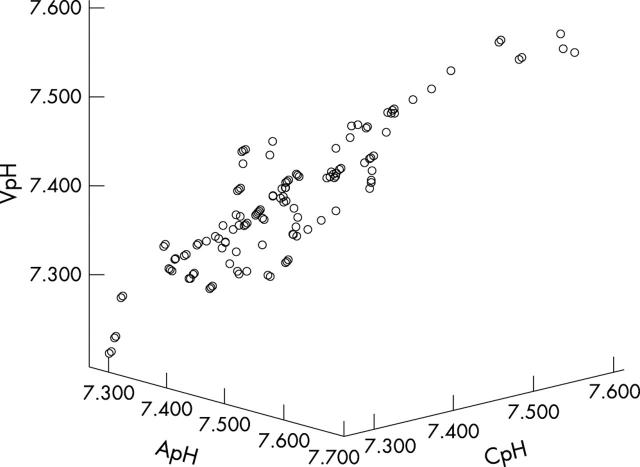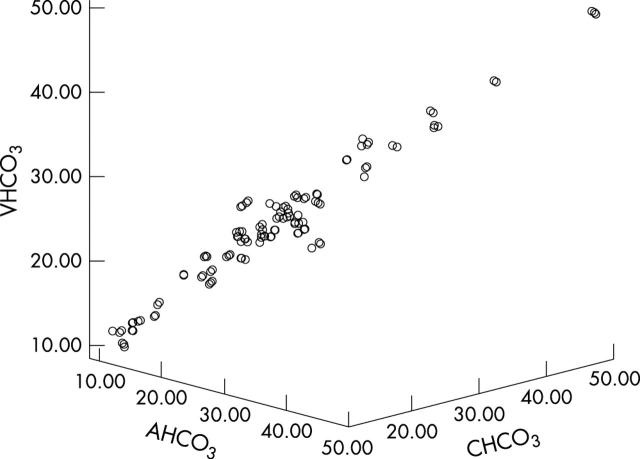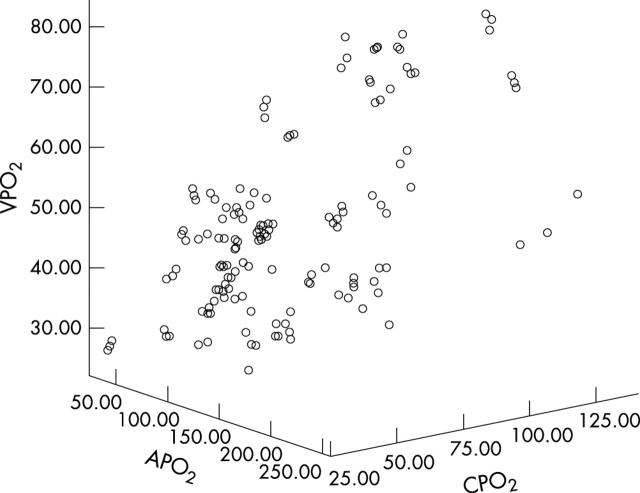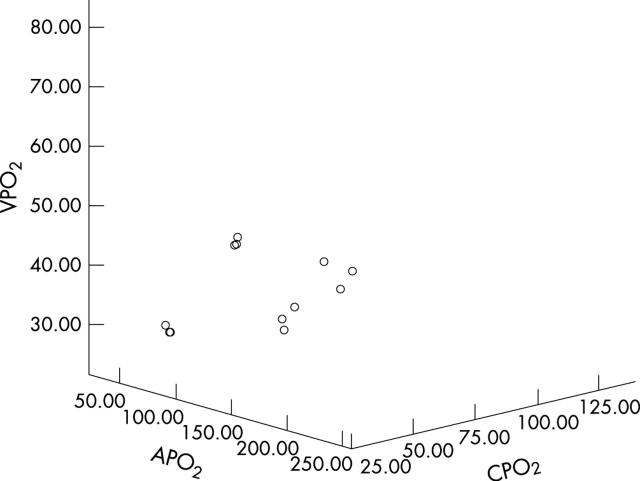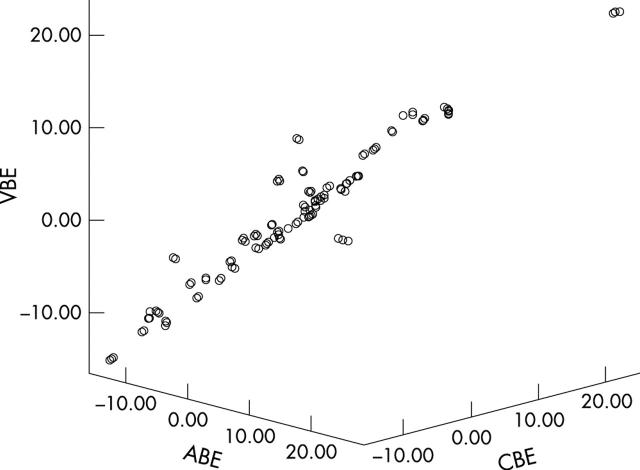Abstract
Aims: To investigate the correlation of pH, partial pressure of oxygen (PO2), partial pressure of carbon dioxide (PCO2), base excess (BE), and bicarbonate (HCO3) between arterial (ABG), venous (VBG), and capillary (CBG) blood gases.
Methods: Patients admitted to the paediatric intensive care unit (PICU) in Çukurova University between August 2000 and February 2002 were enrolled.
Results: A total of 116 simultaneous venous, arterial, and capillary blood samples were obtained from 116 patients (mean age 56.91 months, range 15 days to 160 months). Eight (7%) were neonates. Sixty six (57%) were males. pH, PCO2, BE, and HCO3 were all significantly correlated in ABG, VBG, and CBG. Correlation in PO2 was also significant, but less so. Correlation between pH, PCO2, PO2, BE, and HCO3 was similar in the presence of hypothermia, hyperthermia, and prolonged capillary refilling time. In hypotension, correlation in PO2 between VBG and CBG was similar but disappeared in ABG–VBG and ABG–CBG.
Conclusions: There is a significant correlation in pH, PCO2, PO2, BE, and HCO3 among ABG, VBG, and CBG values, except for a poor correlation in PO2 in the presence of hypotension. Capillary and venous blood gas measurements may be useful alternatives to arterial samples for patients who do not require regular continuous blood pressure recordings and close monitoring of PaO2. We do not recommend CBG and VBG for determining PO2 of ABG.
Full Text
The Full Text of this article is available as a PDF (279.8 KB).
Figure 1 .
Correlation of arterial, venous, and capillary blood gases for pH.
Figure 4 .
Correlation of arterial, venous, and capillary blood gases for HCO3.
Figure 5 .
Correlation of arterial, venous, and capillary blood gases for PO2.
Figure 6 .
Correlation of arterial, venous, and capillary blood gases for PO2 in the presence of hypotension.
Figure 2 .
Correlation of arterial, venous, and capillary blood gases for PCO2.
Figure 3 .
Correlation of arterial, venous, and capillary blood gases for BE.
Selected References
These references are in PubMed. This may not be the complete list of references from this article.
- Adrogué H. J., Rashad M. N., Gorin A. B., Yacoub J., Madias N. E. Assessing acid-base status in circulatory failure. Differences between arterial and central venous blood. N Engl J Med. 1989 May 18;320(20):1312–1316. doi: 10.1056/NEJM198905183202004. [DOI] [PubMed] [Google Scholar]
- Brandenburg M. A., Dire D. J. Comparison of arterial and venous blood gas values in the initial emergency department evaluation of patients with diabetic ketoacidosis. Ann Emerg Med. 1998 Apr;31(4):459–465. doi: 10.1016/s0196-0644(98)70254-9. [DOI] [PubMed] [Google Scholar]
- Connolly H. V., Maginniss L. A., Schumacker P. T. Transit time heterogeneity in canine small intestine: significance for oxygen transport. J Clin Invest. 1997 Jan 15;99(2):228–238. doi: 10.1172/JCI119151. [DOI] [PMC free article] [PubMed] [Google Scholar]
- Courtney S. E., Weber K. R., Breakie L. A., Malin S. W., Bender C. V., Guo S. M., Siervogel R. M. Capillary blood gases in the neonate. A reassessment and review of the literature. Am J Dis Child. 1990 Feb;144(2):168–172. doi: 10.1001/archpedi.1990.02150260046025. [DOI] [PubMed] [Google Scholar]
- Escalante-Kanashiro R., Tantaleán-Da-Fieno J. Capillary blood gases in a pediatric intensive care unit. Crit Care Med. 2000 Jan;28(1):224–226. doi: 10.1097/00003246-200001000-00037. [DOI] [PubMed] [Google Scholar]
- GANDY G., GRANN L., CUNNINGHAM N., ADAMSONS K., Jr, JAMES L. S. THE VALIDITY OF PH AND PCO2 MEASUREMENTS IN CAPILLARY SAMPLES IN SICK AND HEALTHY NEWBORN INFANTS. Pediatrics. 1964 Aug;34:192–197. [PubMed] [Google Scholar]
- Gennis P. R., Skovron M. L., Aronson S. T., Gallagher E. J. The usefulness of peripheral venous blood in estimating acid-base status in acutely ill patients. Ann Emerg Med. 1985 Sep;14(9):845–849. doi: 10.1016/s0196-0644(85)80631-4. [DOI] [PubMed] [Google Scholar]
- Hale P. J., Nattrass M. A comparison of arterial and non-arterialized capillary blood gases in diabetic ketoacidosis. Diabet Med. 1988 Jan;5(1):76–78. doi: 10.1111/j.1464-5491.1988.tb00946.x. [DOI] [PubMed] [Google Scholar]
- Harrison A. M., Lynch J. M., Dean J. M., Witte M. K. Comparison of simultaneously obtained arterial and capillary blood gases in pediatric intensive care unit patients. Crit Care Med. 1997 Nov;25(11):1904–1908. doi: 10.1097/00003246-199711000-00032. [DOI] [PubMed] [Google Scholar]
- McGillivray D., Ducharme F. M., Charron Y., Mattimoe C., Treherne S. Clinical decisionmaking based on venous versus capillary blood gas values in the well-perfused child. Ann Emerg Med. 1999 Jul;34(1):58–63. doi: 10.1016/s0196-0644(99)70272-6. [DOI] [PubMed] [Google Scholar]
- McLain B. I., Evans J., Dear P. R. Comparison of capillary and arterial blood gas measurements in neonates. Arch Dis Child. 1988 Jul;63(7 Spec No):743–747. doi: 10.1136/adc.63.7_spec_no.743. [DOI] [PMC free article] [PubMed] [Google Scholar]
- Rang Louise C. F., Murray Heather E., Wells George A., Macgougan Cameron K. Can peripheral venous blood gases replace arterial blood gases in emergency department patients? CJEM. 2002 Jan;4(1):7–15. doi: 10.1017/s1481803500006011. [DOI] [PubMed] [Google Scholar]
- Saavedra J. M., Harris G. D., Li S., Finberg L. Capillary refilling (skin turgor) in the assessment of dehydration. Am J Dis Child. 1991 Mar;145(3):296–298. doi: 10.1001/archpedi.1991.02160030064022. [DOI] [PubMed] [Google Scholar]
- THOMSEN A. ARTERIAL BLOOD SAMPLING IN SMALL INFANTS. Acta Paediatr. 1964 May;53:237–240. doi: 10.1111/j.1651-2227.1964.tb07232.x. [DOI] [PubMed] [Google Scholar]



